
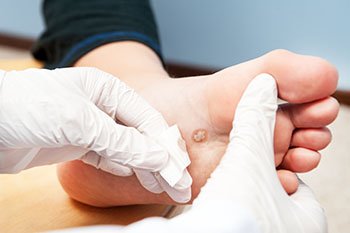
Plantar warts are essentially growths on the feet and they can develop when an individual contracts the human papillomavirus, also known as HPV. These warts can feel hard on the feet and in some cases, they might cause pain. Plantar warts can develop when an individual has skin contact with HPV. Importantly, HPV may be transmitted to someone when they fail to wear shoes in a public area, such as locker rooms and public pool areas. It is also common for someone to contract HPV from infected household members. If you have plantar warts, it might be advisable to take precautions to limit the extent to which you are spreading the human papillomavirus to others. This might include wearing shoes around the house if you live with others. Contact a podiatrist today if you think that you have plantar warts and want to treat this condition.
Plantar warts can be very uncomfortable. If you need your feet checked, contact one of our podiatrists from Grand Blanc Family Footcare. Our doctors will assist you with all of your foot and ankle needs.
About Plantar Warts
Plantar warts are the result of HPV, or human papillomavirus, getting into open wounds on the feet. They are mostly found on the heels or balls of the feet.
While plantar warts are generally harmless, those experiencing excessive pain or those suffering from diabetes or a compromised immune system require immediate medical care. Plantar warts are easily diagnosed, usually through scraping off a bit of rough skin or by getting a biopsy.
Symptoms
Treatment
To help prevent developing plantar warts, avoid walking barefoot over abrasive surfaces that can cause cuts or wounds for HPV to get into. Avoiding direct contact with other warts, as well as not picking or rubbing existing warts, can help prevent the further spread of plantar warts. However, if you think you have developed plantar warts, speak to your podiatrist. He or she can diagnose the warts on your feet and recommend the appropriate treatment options.
If you have any questions please feel free to contact our office located in Grand Blanc, MI . We offer the newest diagnostic and treatment technologies for all your foot and ankle needs.

People who have pain in their big toe may be unaware it can indicate an underlying medical condition. These can include bunions, ingrown toenails, and gout. A bunion is a deformity that is noticeable from the bony lump that forms on the side of the big toe. Gout is a condition that affects the joints in the big toe and can be extremely painful. An ingrown toenail is often noticed by pain in the big toe and can become infected if prompt treatment is not received. Additionally, there may have been an injury that has happened to the metatarsophalangeal, or MTP joint, and this can cause sharp pain in the big toe. It may be difficult to complete daily activities, and larger shoes may need to be purchased. There are several methods to treat toe pain, and it is strongly suggested that you contact a podiatrist to determine the source of your pain.
Toe pain can disrupt your daily activities. If you have any concerns, contact one of our podiatrists of Grand Blanc Family Footcare. Our doctors can provide the care you need to keep you pain-free and on your feet.
What Causes Toe Pain?
Most severe toe pain is caused due to a sports injury, trauma from dropping something heavy on the toe, or bumping into something rigid. Other problems can develop over time for various reasons.
Toe pain can be caused by one or more ailments. The most common include:
When to See a Podiatrist
Diagnosis
In many cases the cause of toe pain is obvious, but in others, a podiatrist may want to use more advanced methods to determine the problem. These can range from simple visual inspections and sensation tests to X-rays and MRI scans. Prior medical history, family medical history, and any recent physical traumatic events will all be taken into consideration for a proper diagnosis.
Treatment
Treatments for toe pain and injuries vary and may include shoe inserts, padding, taping, medicines, injections, and in some cases, surgery. If you believe that you have broken a toe, please see a podiatrist as soon as possible.
If you have any questions please feel free to contact our office located in Grand Blanc, MI . We offer the newest diagnostic tools and technology to treat your foot and ankle needs.

It is important for diabetic patients to practice exceptional foot care because of an increase for an infection to occur when there is a cut, scrape, or bruise on the bottom of the foot. A person who has diabetes has elevated blood sugar, and it is beneficial to monitor these levels daily. Many diabetic patients experience neuropathy when their blood sugar is high, and this can possibly cause the inability to feel if there are existing cuts on the feet. There are several everyday techniques that can be implemented for patients to practice, and this may help them protect the health of their feet. These can include washing and drying the feet thoroughly daily, followed by using a mirror, if necessary, to look at the soles of the feet. It is beneficial to refrain from walking barefoot, and wearing shoes that are comfortable and fit correctly is crucial in maintaining good foot care. Additionally, when the nails are properly trimmed weekly, this may prevent unwanted foot conditions such as ingrown toenails from developing. If you have diabetes, it is strongly suggested that you are under the care of a podiatrist who can offer you correct management tips.
Diabetic foot care is important in preventing foot ailments such as ulcers. If you are suffering from diabetes or have any other concerns about your feet, contact one of our podiatrists from Grand Blanc Family Footcare. Our doctors can provide the care you need to keep you pain-free and on your feet.
Diabetic Foot Care
Diabetes affects millions of people every year. The condition can damage blood vessels in many parts of the body, especially the feet. Because of this, taking care of your feet is essential if you have diabetes, and having a podiatrist help monitor your foot health is highly recommended.
The Importance of Caring for Your Feet
Patients with diabetes should have their doctor monitor their blood levels, as blood sugar levels play such a huge role in diabetic care. Monitoring these levels on a regular basis is highly advised.
It is always best to inform your healthcare professional of any concerns you may have regarding your feet, especially for diabetic patients. Early treatment and routine foot examinations are keys to maintaining proper health, especially because severe complications can arise if proper treatment is not applied.
If you have any questions please feel free to contact our office located in Grand Blanc, MI . We offer the newest diagnostic and treatment technologies for all your foot and ankle needs.
Diabetes affects millions of people every year. Blood vessels located all over the body are damaged due to diabetes—even the blood vessels of the feet. Neuropathy, or nerve damage, can result from slower blood flow in the legs and feet. In diabetic patients, neuropathy is very important to monitor, as diabetics are at risk for developing ulcers.
Always washing and thoroughly drying the feet are pertinent parts of diabetic foot care. There should be a focus on cleaning between the toes. Even if no pain is felt, the entire foot should be examined for redness and sores. Neuropathy can often mask the pain of sores and ulcers and can cause these conditions to be overlooked. Use a mirror to examine the underside of your feet if needed. It is recommended that diabetics wear well-fitting socks.
Patients with diabetes should have their doctor monitor their blood levels because blood sugar levels play a huge role in diabetic care. Monitoring these levels on a regular basis is highly advised. It is very important to keep your blood sugar levels in the normal range, which can be determined by your physician. There are medications that may be prescribed to help with any neuropathy experienced by the diabetic patient. It is also advisable to visit a podiatrist if one is experiencing any conditions involving the feet, such as ingrown toenails, which in more severe cases can cause infection.
Diabetic feet must be inspected daily. Diabetic foot care at home is possible if a patient is provided with instructions from their podiatrist. Patients can relieve dry heels with creams or ointments. Suspected wounds should warrant an immediate call to the podiatrist. Gangrene is a serious problem for diabetics and can lead to sepsis and amputation in its worst cases. Early treatment and daily inspection of diabetic feet are keys to staying healthy.
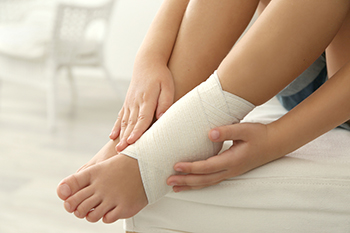
Many people who participate in sports activities experience ankle sprains, although this type of injury is not limited to this particular group of people. Patients from all walks of life that range from being physically fit to having limited exercise experience can incur an ankle sprain. Research has shown the ankle is a common joint that can be injured, and it is often the result of twisting the ankle beyond its normal range of motion. This can happen from stepping off of a curb unexpectedly, or from walking or running on uneven surfaces. Additionally, it can occur from landing improperly on the foot after jumping, or from having endured a fall. An ankle sprain is divided into three classes, consisting of a grade one, two, or three ankle sprain. A mild sprain can be categorized into the grade one class, and there is generally no disability that accompanies this type of sprain. A grade two sprain can cause pain and discomfort, and there may be a slight tear of one or more of the ligaments. The approximate time for a full recovery is six weeks or less. A severe ankle sprain can fall into the grade three class, and often involves a complete tear. This type of sprain can take up to three months to completely heal. If you have endured an ankle sprain, please consult with a podiatrist who can categorize the sprain, and offer correct treatment options.
Although ankle sprains are common, they aren’t always minor injuries. If you need your ankle injury looked at, contact one of our podiatrists from Grand Blanc Family Footcare. Our doctors can provide the care you need to keep you pain-free and on your feet.
How Does an Ankle Sprain Occur?
Ankle sprains are the result of a tear in the ligaments within the ankle. These injuries may happen when you make a rapid shifting movement while your foot is planted. A less common way to sprain your ankle is when your ankle rolls inward while your foot turns outward.
What Are the Symptoms?
Preventing a Sprain
Treatment of a Sprain
In many cases, the RICE method (Rest, Ice, Compression, and Elevate) is used to treat ankle sprains. However, you should see a podiatrist to see which treatment option would work best with your injury. In severe cases, surgery may be required.
It is important to ask your doctor about rehab options after you receive treatment for your injury. Stretching, strength training, and balance exercises may help the ankle heal while also preventing further injury.
If you have any questions, please feel free to contact our office located in Grand Blanc, MI . We offer the newest diagnostic and treatment technologies for all your foot care needs.
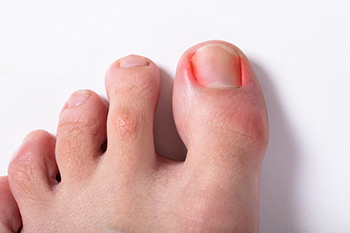
An ingrown toenail is easy to notice. The side of the toenail grows into the skin instead of over it. It can be quite uncomfortable, and in severe cases, may bleed, and become infected. It can happen for a variety of reasons, such as wearing shoes that do not have enough room in the toe area, having endured a toe injury, or from trimming the toenails improperly. Genetic reasons may contribute to getting an ingrown toenail, and this may account for people who naturally have curved toenails, or have toenails that are too large for their toes. Common symptoms that are associated with ingrown toenails include redness, swelling, and pain. The affected toe may temporarily feel better when it is soaked in warm water, which can soften the nail. This may make it easier to pull the skin away from the toe, despite the fact it may not last. If you have an ingrown toenail, there is a chance it can become infected, and it is strongly advised that you consult with a podiatrist as quickly as possible who can offer professional treatment.
Ingrown toenails may initially present themselves as a minor discomfort, but they may progress into an infection in the skin without proper treatment. For more information about ingrown toenails, contact one of our podiatrists of Grand Blanc Family Footcare. Our doctors can provide the care you need to keep you pain-free and on your feet.
Ingrown Toenails
Ingrown toenails are caused when the corner or side of a toenail grows into the soft flesh surrounding it. They often result in redness, swelling, pain, and in some cases, infection. This condition typically affects the big toe and may recur if it is not treated properly.
Causes
You are more likely to develop an ingrown toenail if you are obese, have diabetes, arthritis, or have any fungal infection in your nails. Additionally, people who have foot or toe deformities are at a higher risk of developing an ingrown toenail.
Symptoms
Some symptoms of ingrown toenails are redness, swelling, and pain. In rare cases, there may be a yellowish drainage coming from the nail.
Treatment
Ignoring an ingrown toenail can have serious complications. Infections of the nail border can progress to a deeper soft-tissue infection, which can then turn into a bone infection. You should always speak with your podiatrist if you suspect you have an ingrown toenail, especially if you have diabetes or poor circulation.
If you have any questions, please feel free to contact our office located in Grand Blanc, MI . We offer the newest diagnostic and treatment technologies for all your foot care needs.

With any sport, there is risk of injury while training or playing. This is true for American football as well. The four most common foot injuries among football players are an Achilles tendon rupture, turf toe, a Jones fracture, and plantar fasciitis. An Achilles rupture often happens to football players who train intensively after a period of inactivity, such as at the start of a new season. Achilles tendonitis is inflammation of the tendon located at the back of the foot above the heel, but a rupture is more serious and involves a partial or complete tear. Turf toe is a sprain of the big toe joint. Football players are continually pushing off the ground from the toes, and overextension of the big toe joint can result. This is especially common when playing on artificial turf because of its gripping nature. A Jones fracture is also called a 5th metatarsal fracture. The 5th metatarsal is the long bone that runs on the outside of the foot that connects to the baby toe. It can break from sudden impact, a poor landing, repeated stress, or overuse. This injury can recur if not healed properly. The stud or cleat under a football boot can cause swelling of the tissue that runs under the foot, known as plantar fasciitis. These injuries might be prevented by warming up well, increasing training slowly, wearing supportive football boots, and possibly adding sports inserts. If you or your loved one plays football and has sustained a foot injury, see a podiatrist who can offer a proper diagnosis and treatment options.
Ankle and foot injuries are common among athletes and in many sports. They can be caused by several problems and may be potentially serious. If you are feeling pain or think you were injured in a sporting event or when exercising, consult with one of our podiatrists from Grand Blanc Family Footcare. Our doctors will assess your condition and provide you with quality foot and ankle treatment.
Common Injuries
The most common injuries that occur in sporting activities include:
Symptoms
Symptoms vary depending upon the injury and in some cases, there may be no symptoms at all. However, in most cases, some form of symptom is experienced. Pain, aching, burning, bruising, tenderness, tightness or stiffness, sensation loss, difficulty moving, and swelling are the most common symptoms.
Treatment
Just as symptoms vary depending upon the injury, so do treatment options. A common treatment method is known as the RICE method. This method involves rest, applying ice, compression and elevating the afflicted foot or ankle. If the injury appears to be more serious, surgery might be required, such as arthroscopic or reconstructive surgery. Lastly, rehabilitation or therapy might be needed to gain full functionality in the afflicted area. Any discomfort experienced by an athlete must be evaluated by a licensed, reputable medical professional.
If you have any questions, please feel free to contact our office located in Grand Blanc, MI . We offer the newest diagnostic and treatment technologies for all your foot care needs.
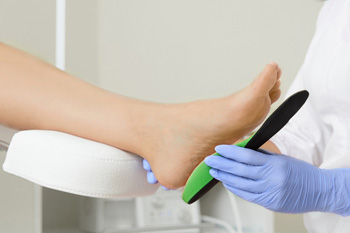
Many people need to wear orthotics in their shoes. They are defined as custom-made insoles that can help a variety of foot conditions and may also be used to improve ankle support. A proper diagnosis can determine if orthotics are right for you. This can consist of having a physical examination performed on the feet, discussing existing symptoms, and checking for painful deformities. Additionally, an X-ray or MRI may be ordered that can show any signs of arthritis or damage to the foot. There are some foot conditions that can alter the foot structure including bunions, hammertoes, heel spurs, or flat feet. There are two categories of orthotics consisting of rigid and flexible and may be available in two sizes, full-shoe inserts or smaller inserts that the heels can fit in. If you have a foot ailment and would like more information about the benefits of wearing custom-made orthotics, it is strongly advised that you seek the counsel of a podiatrist.
If you are having discomfort in your feet and would like to try orthotics, contact one of our podiatrists from Grand Blanc Family Footcare. Our doctors can provide the care you need to keep you pain-free and on your feet.
What Are Orthotics?
Orthotics are inserts you can place into your shoes to help with a variety of foot problems such as flat feet or foot pain. Orthotics provide relief and comfort for minor foot and heel pain but can’t correct serious biomechanical problems in your feet.
Over-the-Counter Inserts
Orthotics come in a wide variety of over-the-counter inserts that are used to treat foot pain, heel pain, and minor problems. For example, arch supports can be inserted into your shoes to help correct overarched or flat feet, while gel insoles are often used because they provide comfort and relief from foot and heel pain by alleviating pressure.
Prescription Orthotics
If over-the-counter inserts don’t work for you or if you have a more severe foot concern, it is possible to have your podiatrist prescribe custom orthotics. These high-quality inserts are designed to treat problems such as abnormal motion, plantar fasciitis, and severe forms of heel pain. They can even be used to help patients suffering from diabetes by treating foot ulcers and painful calluses and are usually molded to your feet individually, which allows them to provide full support and comfort.
If you are experiencing minor to severe foot or heel pain, it’s recommended to speak with your podiatrist about the possibilities of using orthotics. A podiatrist can determine which type of orthotic is right for you and allow you to take the first steps towards being pain-free.
If you have any questions please contact our office located in Grand Blanc, MI . We offer the newest diagnostic and treatment technologies for all your foot and ankle needs.
Ankle foot orthotics are shoe inserts that offer support to control the placement and movement of the ankle, correct deformities, and compensate for weakness. These inserts are used to stabilize the foot and ankle and provide toe clearance during the swing phase of gate.
Athletes often suffer foot problems because their feet are not being supported within the shoe. Ankle and foot orthotics are custom made inserts that alleviate stress on the foot. However custom orthotics should be prescribed by a podiatrist who specializes in customized footwear and orthotics design. These inserts are used by athletes for different reasons. Runners use orthotics to absorb shock at heel contact and to set up the forefoot for push-off. Basketball players wear them to control their forefeet while jumping and running.
The two main types of orthotics are over-the-counter orthotics and custom-made orthotics. To be eligible for custom orthotics, an examination of the foot and ankle will need to be completed. Afterward, both the foot and ankle will need to be casted and fitted for the proper orthotic. When the fitting process is complete, adjustments can be made to make sure everything fits perfectly.
Over the counter orthotics tend to be more popular than custom fit ones. Athletes who have less severe aches and pains in the foot, ankle or lower back area can use the over-the-counter version of orthotics. Unfortunately, over-the-counter orthotics tend to not work in treating severe injuries or ailments. Whenever you suspect you may need an ankle foot orthotic, you should consult with your podiatrist to determine which type of orthotic is right for you.
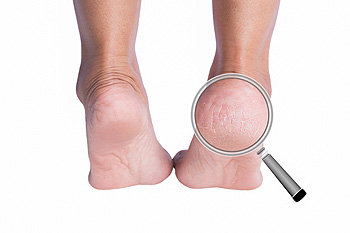 This is much less likely to happen in children than adults because kid’s feet are so tender and mechanical foot factors are not at play yet. However, there are situations where children can have cracked heels. Usually, a child has something abnormal going on with their immune system which impacts the functioning of their skin. Cracks can happen with disorders of nervous system regulation or hormones. Cracked heels can come on with stress, neuropsychic overstrain, or insufficient nutrition, particularly with a deficiency in vitamins B, A, and/or E. If cracks appear, it is usually during a transition period, such as adapting to going to school, the onset of adolescence, or from shock (like in the divorce of parents). Skin can become dry and flaky in response to stressors. As with adults, cracks in children’s feet need attention so as not to become infected and turn into wounds. If your child has cracked heels, protect the heel by covering it with a band-aid, and it is suggested you then take him or her to a podiatrist for appropriate treatment.
This is much less likely to happen in children than adults because kid’s feet are so tender and mechanical foot factors are not at play yet. However, there are situations where children can have cracked heels. Usually, a child has something abnormal going on with their immune system which impacts the functioning of their skin. Cracks can happen with disorders of nervous system regulation or hormones. Cracked heels can come on with stress, neuropsychic overstrain, or insufficient nutrition, particularly with a deficiency in vitamins B, A, and/or E. If cracks appear, it is usually during a transition period, such as adapting to going to school, the onset of adolescence, or from shock (like in the divorce of parents). Skin can become dry and flaky in response to stressors. As with adults, cracks in children’s feet need attention so as not to become infected and turn into wounds. If your child has cracked heels, protect the heel by covering it with a band-aid, and it is suggested you then take him or her to a podiatrist for appropriate treatment.
Cracked heels are unsightly and can cause further damage to your shoes and feet. If you have any concerns, contact one of our podiatrists from Grand Blanc Family Footcare. Our doctors can provide the care you need to keep you pain-free and on your feet.
Cracked Heels
Cracked heels appear unappealing and can make it harder for you walk around in sandals. Aside from looking unpleasant, cracked heels can also tear stockings, socks, and wear out your shoes. There are several methods to help restore a cracked heel and prevent further damage.
How Do You Get Them?
Dry skin is the number one culprit in creating cracked heels. Many athletes, walkers, joggers, and even swimmers suffer from cracked heels. Age and skin oil production play a role to getting cracked heels as well.
Promote Healing
Over the counter medicines can help, especially for those that need instant relief or who suffer from chronic dry feet.
Wear Socks – Wearing socks with medicated creams helps lock in moisture.
Moisturizers – Applying both day and night will help alleviate dryness which causes cracking.
Pumice Stones – These exfoliate and remove dead skin, which allows for smoother moisturizer application and better absorption into the skin.
Change in Diet
Eating healthy with a well-balanced diet will give the skin a fresh and radiant look. Your body responds to the kinds of food you ingest. Omega-3 fatty acids and zinc supplements can also revitalize skin tissue.
Most importantly, seek professional help if unsure how to proceed in treating cracked heels. A podiatrist will help you with any questions or information needed.
If you have any questions, please feel free to contact our office located in Grand Blanc, MI . We offer the newest diagnostic and treatment technologies for all your foot care needs.